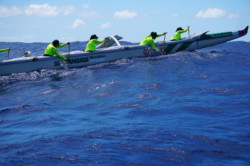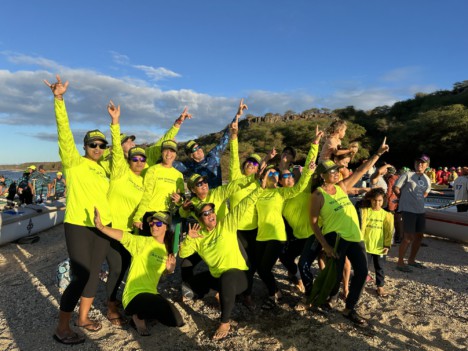Na Wahine Paddlers ‘Do It for Molokai’
Ten Molokai women from Wa’akapaemua Canoe Club paddled the notoriously rough waters of the Ka’iwi Channel in the world championship of women’s outrigger canoe paddling, Na Wahine O Ke Kai, on Sept. 29. It was the first time the race was held since 2019, after being canceled for the pandemic and last year’s deadly Maui wildfire. Hundreds of paddlers gathered from as far as Japan, Australia and New York, along with dozens of Hawaii crews.
The Molokai team of open division wahine – Pualei Lima, Kalei Adolpho, Courtney-Rhyan Turner, Honora Kalama, Nicole Schroeter, Lili’uokalani Kapuni, Sarajane Larkin, Kaala English, Sybil Lopez and Ishay Kaholoaa — left it all on the water during their top 20 finish. Erika Espaniola trained as alternate. Many of them are mothers and grandmothers, working full time jobs and juggling a slew of other commitments. They battled physical fatigue and mental exhaustion, navigated unpredictable ocean currents and relied on their rigorous training to carry them through.
It’s been five months of grueling practices and sacrifices for the crew, building up the endurance to paddle for seven hours across open ocean.
Hard Work and Family Ties
For Lima, she said she couldn’t put in the hours of training without the support of her ‘ohana helping to care for her three kids, the youngest being just eight months old. Paddling is part of her family’s DNA.
Her grandfather, Mervin Dudoit, competed in one of the first Molokai Hoe crossings in the early1950s.
“Both sides of my family are paddlers,” Lima said. “I feel good every time I pau practice or take my kids to my papa’s house. He asks me, ‘You going paddle?’ ‘Yeah, practice,’ and he gets all excited, and I know he’s proud of me, and my cousins too [doing the upcoming men’s Molokai Hoe].”
For many of the crew, it’s also a chance to connect with their culture.
Kaala English, who has completed six channel crossings, said being on the water means the opportunity to feel her kupuna with her.
“I go there to be with them. I get to talk to them. I get to feel them,” she said, “Because sometimes, I’m just dead, because we’re working moms. You work all day, you go home, you still get homework, you get dinner, you got all these things, and then you go out there, and you just feel one with the water. And it’s just something that gives you the feeling to want to be there… and it feels so good. I just feel so culturally connected when I’m out there.”
Their coach is Keola “Boomski” Kino. His nickname stems from a phrase he coined during a game of horseshoes years ago and the crew has adopted it: “Team Boomski.”
Kino has done more Ka’iwi crossings than he can count. He initially became the coach of the Wa’akapaemua open women’s team in 2011, promising to help them win medals.
“They asked me to coach, and I told them, ‘You sure? Because we going to train hard’ — we train them like how my dad trained people.,” he said. His father, Dutchy Kino, was well-known in the paddling community for his contributions to the sport. “You gotta train hard, because you no like just be one participant – you like go to the podium.”
Lima can attest to the rigorous practices.
“He’s hard, but he prepares us for this stuff, as far as the training — like round and round and round [doing circuits on the water], we don’t stop. No water breaks. Keep going,” she said. “He pushes us to our limits.”
On the Water
On race day, the sun rose at Hale O Lono over 48 canoes – about half of typical registration before the race took its hiatus. After a pule and opening ceremony, competitors launched their canoes into the harbor toward the starting line.
In the first miles of the race, crews vied for an early lead before spreading out as they reached open ocean.
Six women paddle at a time, while four are on the escort boat. Throughout the race, paddlers trade off in “water changes.”
The escort boat, captained by Molokai paddler Bozo Dudoit, pushes ahead of the canoe and makes a U-turn in front of the approaching wa’a. Paddlers plunge off the escort into the ocean and line up in the water. Those in the wa’a jump out while the new paddlers hoist themselves into the moving wa’a.
“Gotta hustle, gotta hustle!” Kino urges.
Some paddlers hook their leg over the gunnel and swing in. Others pull straight up. Whatever the method, speed is critical. As soon as they’re in the wa’a, they start paddling again.
“Paddle, paddle, c’mon girls, don’t lose what you guys earned!” Kino shouts.
Those aboard the escort boat throw a line out to the exhausted paddlers in the water. They rest, eat and hydrate for their next change.
During the race, the crew fuels up on poi, deer jerky, watermelon and ‘uala. Then, when they’re nearing the finish, it’s candy bars and Coca-Cola for the final push.
SJ Larkin served as the crew’s steerswomen. She completed the channel “iron” – meaning she paddled the entire race with no breaks. Each of the six seats in the canoe has its own role, but the steersperson is especially critical in safely crossing the channel. As she made final preparations for the crossing on the sand at Hale O Lono, Larkin talked about her goals.
“Listening to coach, having a good line, feeling the water and the current, and if need be, keeping an eye on that ama and safety, and my biggest — in and out changes,” she said. “People can get hurt, lining them up, picking them up safely.”
This year’s conditions were favorable, with light winds and low swells. But some years, towering waves make water changes dangerous.
Team Boomski held a top 10 place for several hours. As Oahu looms closer, crews converge from the open ocean towards the finish. They pass Diamond Head, then follow the coastline towards Waikiki.
“Today’s the day, gang, today’s the day! Keep it hot!” Kino yells. “Tap, tap, tap!”
In the final 10 miles, fatigue sets in, but also excitement.
“We worked for this moment, ladies!” paddlers cheer from the escort.
In the final stretch, Team Boomski passes two other crews, securing a top 20 finish for Wa’akapaemua.
Molokai paddlers Kealani Bartlett and Coral Mariano were also part of the first place Team Bradley. Molokai’s Hoku Keala came in second, paddling with Oahu’s Ka Lahui Kai, and Sydney Yap-Kalipi finished fifth, also with Ka Lahui Kai.
At the finish line, first-timer Lili’uokalani Kapuni of Team Boomski was full of pride for her crew.
“Depend on your team that they got your back and you got theirs. It was an amazing experience,” she said. “We’re all healthy, we’re all safe, no one got hurt, and we all got smiles on our face from ear to ear — that’s what matters the most.”
 Ishay Kaholoaa, who also completed her first Ka’iwi Channel crossing this year, had a special motivation during the race.
Ishay Kaholoaa, who also completed her first Ka’iwi Channel crossing this year, had a special motivation during the race.
“I just got a granddaughter two weeks ago, and she’s down here [on Oahu] in the NICU. So all I could think was getting down here to my grandbaby, so that’s what I was thinking through the whole way,” she said, her voice full of emotion.
The Early Days
Na Wahine Race Director Luana Froiseth has completed the crossing herself nearly 30 times.
“These two races, Na Wahine O Ke Kai and Molokai Hoe, they’re not only the Olympics of canoe paddling, but it’s Hawaii’s heritage,” she said. “These races started on Molokai. Molokai won the first Molokai to Oahu race. This is our culture.”
The Molokai Hoe and Na Wahine O Ke Kai are long-standing traditions on Molokai.
Legendary Molokai paddler and Hokule’a crewmember Penny Martin didn’t compete in Na Wahine O Ke Kai this year, but she’s done 15 crossings in the past.
She said in the early days of the men’s race, it was a “huge holiday” on the island.
“Pretty much the whole island looked forward to it and was involved in one way or another. And if they weren’t involved, they participated,” she recalled. “So it was like this huge holiday, this huge event, that got people excited, not just for the paddling, but the whole spirit of the thing — people coming together and celebrating canoes and paddling.”
The Molokai Hoe started in 1952, but women didn’t cross the Ka’iwi for decades after that.
Coaches and officials didn’t believe wahine could handle the potentially treacherous conditions. Martin recalled her coach at the time, when she was in her early 20s, saying, “No, the women will never do the channel.”
“And then, after being shut down so many times, [women] decided that, ‘you know what, we just got to do it and show them,’” Martin said.
She recalled being at Hale O Lono harbor one year helping with the Molokai Hoe.
“These women came down, and some of them I recognized – they were from Oahu,” she said. “’What are you guys doing?’ ‘We’re going to do the channel,’ [they said]. And I thought, ‘Wow, that’s so cool. And how brave.’
Two women’s crews successfully completed the crossing for the first time in 1975, and four years later, Na Wahine O Ke Kai race became official.
‘We do it for Molokai’
Martin said today, paddling remains bigger than just competing.
“I want people to remember that we’re paddling Hawaiian canoes, and this is a Hawaiian tradition, and , this is part of our culture,” she said. “It’s not just another race, right? It is part of our culture. And we’re not just doing a canoe race. We’re celebrating our culture and staying plugged in.”
Martin hopes the lessons of the wa’a will remain strong.
“I think one of the most beautiful things about padding in a six man or four man or two man is that you can’t move that canoe by yourself,” she said. “And you really learn the value of working together and being there for each other to make things move.”
For the women who completed this year’s race, “working together” extended beyond just their crew and ‘ohana.
“Obviously, our families support us, but it’s bigger than just our families. It’s our whole island,” Lima said of paddling Na Wahine O Ke Kai.
“We do it for our people, we do it for home, we do it for Molokai,” said English. “When I go, they all come with me — like all of Molokai comes with us. So that’s kind of like the magic of it — they’re all pulling with us, for us.”
This Sunday, Oct. 13 the men will take on the Molokai Hoe, with another open division team from Wa’akapaemua Canoe Club.












Don't have a Molokai Dispatch ID?
Sign up is easy. Sign up now
You must login to post a comment.
Lost Password